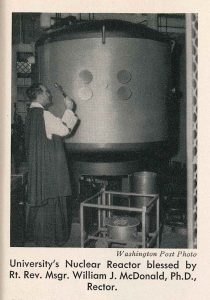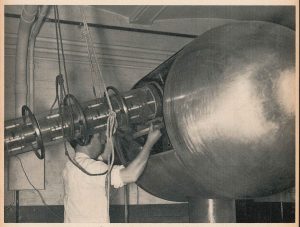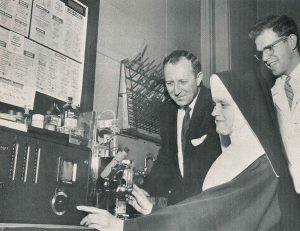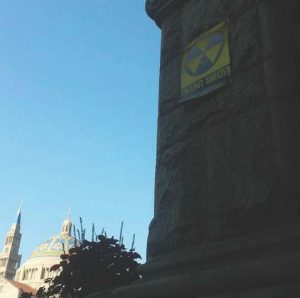
“Saturday: Atomic Reactor Demonstration, Tour of National Shrine, Open House Library Science……11:30 & 12:45”
-Homecoming ’58 Schedule, Tower, November 14, 1958
In the fall of 1957, an AGN-201 nuclear training reactor was installed on the Catholic University campus. Originally located in the Nuclear Training Laboratory of the campus Power Plant, this reactor was a compact unit standing nine feet tall and weighing 12 tons. Capable of producing 100 milliwatts of energy – only enough to light a single Christmas tree bulb! – the unit was not intended for powering campus offices but providing a controlled model to train budding nuclear engineers, power plant operators, and faculty researchers. For over 20 years, the reactor was at the heart of a close relationship between the Atomic Energy Commission (AEC) and the University. But why Catholic University and why a nuclear reactor?

To understand this partnership, one must understand the fears and hopes of the post-war Atomic Age. While there were fears about the destructive potential of nuclear technology, scientific and political leaders also recognized its awesome potential for good. Advancements in nuclear monitoring and reactor development, declassification of technics, and concern over losing scientific ground to the Soviet Union provided the impetus for Congress to pass the Atomic Energy Acts of 1954 and 1955. These Acts authorized the AEC to provide grant monies to engineering schools for nuclear equipment, ranging from reactors for training power plant operators to biomedical equipment to study radiation’s effects on cancer cells. Catholic University, with its centrality in the nation’s capital and having previously established a nuclear science and engineering program under the joint guidance of the Department of Physics and School of Engineering in 1956, was well-placed to apply for a grant.
With a storied history of aviation innovation with the first experimental wind tunnel in the United States, by the early 1940s, the Physics Department was one of only two Catholic institutions in the United States to possess an “atom smasher.” Maintained by Herzfeld and Talbott, this “smasher” was an apparatus that produced high electrical voltage to charge particles.

Receiving over $123,000 to acquire the reactor, this became the first of many AEC grants the University would receive in the coming decades. Among the many projects funded by this program was a radioactive isotope laboratory, under the auspices of the Department of Biology, specializing in retarding cancer growth cells in mice. Physics was also provided additional funds to continue the neutrino research of Dr. Clyde Cowan, who had co-discovered the neutrino in 1956. Dr. Cowan joined the Department in 1958. Numerous scientific luminaries were associated with the grant program, including: Drs. Francis Leo Talbott, Karl Herzeld and Clyde Cowan of Physics; Dean Donald Marlowe of Engineering; and Dr. Dale C. Braungart of Biology.
The reactor was relocated several times during its tenure, residing in the Power Plant, McGivney Hall (then known as Keane Hall), and Pangborn Hall. McGivney was even originally constructed in 1958 to serve as a center for physics research, with its deep basement levels providing reduced background interference for the experiments to be conducted. But by the late 1970s, some of the initial public optimism of the Atomic Age had waned following the aftermath of the Three Mile nuclear incident and continuing fears of nuclear war. Although the reactor had been inactive for several years at that point, concerns were raised about its continued presence on campus. By the early 1990s, it was fully decommissioned and removed from campus.

While this partnership with the AEC thankfully resulted in no giant lizards stomping across the Brookland neighborhood, it did inspire a generation of innovative research and budding engineers, a legacy that continues in the sciences on campus today, whether through the Vitreous State Laboratory’s research into safe nuclear storage or partnerships with NASA.
In addition, the Archives holds the papers of Dr. Clyde Cowan: https://findingaids.lib.catholic.edu/repositories/2/resources/66
